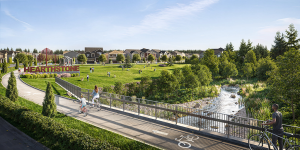A total precast concrete building solution enabled the St. Teresa Place Supportive Living Facility in Calgary, Alta. to be completed in two years instead of three.
The project was discussed in a video presentation during a session called Rapid Construction of Advanced Health Care Facilities at The Buildings Show recently, which outlined how to build facilities faster, a need that became more apparent during the COVID-19 pandemic.
The build is a sample of Accelerated Building Construction (ABC).
The four-storey, 250-bed, 205,000-square-foot continuing care facility is located in the Redstone neighbourhood of Calgary. Construction was completed in 2017.
“For a fast and sustainable construction method our solution begins with an insulated sandwich wall panel which includes an exterior concrete skin with variable finishes, a continuous layer of insulation and the load bearing structure,” said Ignacio Cariaga, senior cement technical services manager with LeHigh Cement Canada, formerly with Armtec, the main precast contact on the project. “Having the structural mass of concrete inside the insultation enhances the thermal storage properties of the wall.”
The pieces were built off site in a controlled environment with tight quality control.
“The beauty of the design is the repetitiveness of the construction,” Cariaga said. “After it is co-ordinated through a BIM model, it’s like putting together a Lego set. We were able to build a shell of the building in no time at all, allowing the contractors to do their work inside. While one wing was being built another crane was already starting on the second wing.”
The structure, which was supplied by Armtec, is comprised of architectural insulated wall panels, solid interior wall panels, precast columns, stair stringers, steel Deltabeams and hollow core floor and roof slabs, states the Canadian Precast Prestressed Concrete Institute (CPCI) website.
“We were able to construct the building in four months compared to conventional construction time of 16 months,” explained Cariaga.
The way the project was designed is what allowed the building to be constructed faster, said Kevin Juby, partner at Manshield Construction.
“Our mechanical and electrical trades, which are key to the process, were on the first floor snapping lines and starting rough ins while the precast on the third floor was being built,” he said. “This system provided us an enclosed structure in a controlled environment which afforded our teams maximum productivity through the winter months.”
Christopher Babits, principal with FWBA Architects, said the decision to build with precast concrete informed the design. LEAN schematic design for the facility determined the most efficient layout of space.
“Our approach was to turn limitations into opportunities,” he noted. “Concrete surface treatments and creative use of colour and texture and depth enabled a four-storey design to harmonize with a two-storey neighbourhood. A hollow core floor system together with innovative Deltabeams offered us the thinnest floor structure possible.”
Armtec created architectural features and elements with formliners and concrete stains, the CPCI website states, adding seven different forms were used to create 32 different sizes and styles of architectural panels and a penetrating concrete stain was used to attain several different colours on the building.
“As architects we are always looking for performance durability and sustainability,” he added. “These locally manufactured concrete panels may look like wood or stone or stucco but have a radically longer anticipated lifecycle.”
Inside, the space is designed with bright colours, natural light and warm finishes. The facility features six supported living neighbourhoods each with 33 private suites, including some for couples.
Patrick Dumelie, CEO of Covenant Health, Covenant Care and Covenant Living, was pleased with the innovative approaches used on the project.
“We’ve been able to build a building that is not only cost effective and safe, it’s non-combustible but it’s also very flexible meeting our residents needs no matter what they are from very complex to supportive living,” Dumelie said.
The project team consisted of Covenant Care (owner); FWBA Architects (architect); Manshield Construction (general contractor); Armtec Precast (precast supplier, the Armtec Member was sold to a few other CPCI members); and MPE Engineering Ltd. (engineering consultant).
Follow the author on Twitter @DCN_Angela.











Recent Comments
comments for this post are closed